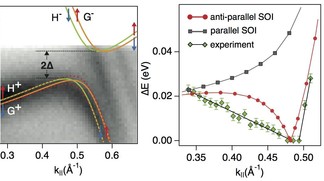Jan 28 2014
In a recent publication B. Slomski and co-workers have been able to follow how spin-orbit interaction causes anti-prallel spin states to interact. The resulting spin flip yields an unexpected spin texture.
 © 2014 EPFL
© 2014 EPFL
In a 2D electron gas, such as a surface state or quantum well state, the spin-orbit interaction lifts the spin degeneracy according to the Rashba effect. The size of the spin splitting depends on several aspects, such as atomic species and atomic structure, and the spin texture is typically seen as two states with opposite helicity. It is well known that if a variety of states is present, those states with parallel spin can interact and form an avoided crossing gap. However, Bartosz Slomski and co-workers showed that also anti-parallel spin states can interact through a domino-like momentum dependent spin flip mechanism.
To directly study this effect ultra thin Pb films of exactly 10 atomic layers were grown on a silicon substrate. Under those conditions very sharp quantum well states form in the film, which are split according to the Rashba effect. The spin structure of these states was then mapped as a function of in-plane momentum using spin- and angle-resolved photoemission at the Swiss Light Source. It was found that if two sets of Rashba-split states come close to each other the spin-orbit interaction causes the spin to flip and states with anti-parallel spin to interact. As a result the spin texture reverses the helicity with pronounced consequences for spintronics applications.
Besides these novel results the paper also gives a very nice overview of the status of research into the spin properties of metallic quantum well states.